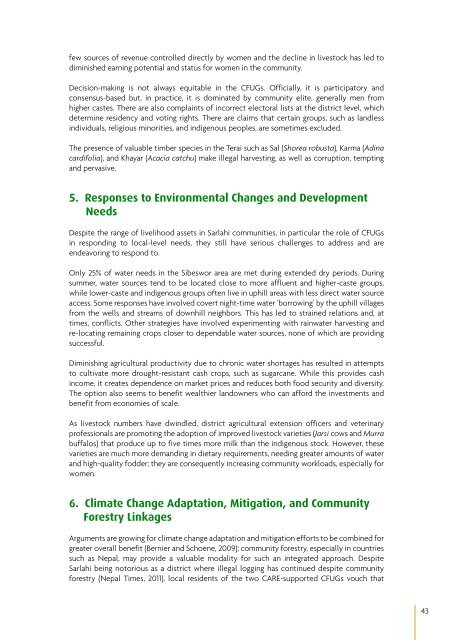Adaptation case studies.pdf - RECOFTC
Adaptation case studies.pdf - RECOFTC
Adaptation case studies.pdf - RECOFTC
You also want an ePaper? Increase the reach of your titles
YUMPU automatically turns print PDFs into web optimized ePapers that Google loves.
few sources of revenue controlled directly by women and the decline in livestock has led todiminished earning potential and status for women in the community.Decision-making is not always equitable in the CFUGs. Officially, it is participatory andconsensus-based but, in practice, it is dominated by community elite, generally men fromhigher castes. There are also complaints of incorrect electoral lists at the district level, whichdetermine residency and voting rights. There are claims that certain groups, such as landlessindividuals, religious minorities, and indigenous peoples, are sometimes excluded.The presence of valuable timber species in the Terai such as Sal (Shorea robusta), Karma (Adinacardifolia), and Khayar (Acacia catchu) make illegal harvesting, as well as corruption, temptingand pervasive.5. Responses to Environmental Changes and DevelopmentNeedsDespite the range of livelihood assets in Sarlahi communities, in particular the role of CFUGsin responding to local-level needs, they still have serious challenges to address and areendeavoring to respond to.Only 25% of water needs in the Sibeswor area are met during extended dry periods. Duringsummer, water sources tend to be located close to more affluent and higher-caste groups,while lower-caste and indigenous groups often live in uphill areas with less direct water sourceaccess. Some responses have involved covert night-time water ‘borrowing’ by the uphill villagesfrom the wells and streams of downhill neighbors. This has led to strained relations and, attimes, conflicts. Other strategies have involved experimenting with rainwater harvesting andre-locating remaining crops closer to dependable water sources, none of which are providingsuccessful.Diminishing agricultural productivity due to chronic water shortages has resulted in attemptsto cultivate more drought-resistant cash crops, such as sugarcane. While this provides cashincome, it creates dependence on market prices and reduces both food security and diversity.The option also seems to benefit wealthier landowners who can afford the investments andbenefit from economies of scale.As livestock numbers have dwindled, district agricultural extension officers and veterinaryprofessionals are promoting the adoption of improved livestock varieties (Jarsi cows and Murrabuffalos) that produce up to five times more milk than the indigenous stock. However, thesevarieties are much more demanding in dietary requirements, needing greater amounts of waterand high-quality fodder; they are consequently increasing community workloads, especially forwomen.6. Climate Change <strong>Adaptation</strong>, Mitigation, and CommunityForestry LinkagesArguments are growing for climate change adaptation and mitigation efforts to be combined forgreater overall benefit (Bernier and Schoene, 2009); community forestry, especially in countriessuch as Nepal, may provide a valuable modality for such an integrated approach. DespiteSarlahi being notorious as a district where illegal logging has continued despite communityforestry (Nepal Times, 2011), local residents of the two CARE-supported CFUGs vouch that43
















